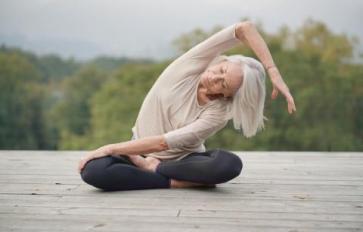
Bloating, cramps, headaches, body aches, swelling, breast tenderness, mood swings -- is this what we were destined for? To a young girl newly entering puberty I knew nothing better. I entered the era of menstruation without proper initiation or training. I had no wisdom-woman grooming me in the way to consciously awaken into my womanhood. I only had societal conditioning, programming, and a mother who grew up with shame and guilt around bleeding. Naturally, my body responded by going into fits of almost unbearable pain (and sometimes beyond). I was resisting womanhood on every front and society had a name for it -- PMS.
As a woman, we often become accustomed to dealing with discomforts in our bodies when the truth is, they could be relieved much easier than we have been taught to believe. By adding simple yoga postures and techniques into our daily routines the symptoms of PMS can quickly melt away and reveal our true nature behind the parts of us that have felt foreign and uncomfortable.
By far one of the most effective practices to add to your lifestyle regime in order to help alleviate the symptoms of PMS is a regular yoga class, or at the very least, a couple of simple postures and techniques. Designed to regulate the endocrine gland system, yoga targets the hormones in the body and helps to bring them into balance and harmony, but not only this. Yoga is a holistic means through which we can access the entirety of ourselves and integrate all parts of the self. By starting with just 15 minutes per day, your entire month can transform into a space of beauty and strength rather than one of bloating, disconnection, and discomfort.
Breathing for PMS
The best place to start is with the breath. By first beginning to notice, and then gently altering the breath, the entire body can be shifted as the mastery of the breath equals mastery of the body/mind. These two simple breathing practices (also called pranayama) can help you harness the breath first, and the deeper wisdoms of the body complex later.
Viloma Breathing: This breath is known as “reverse breathing” because instead of allowing the breath to be automatic and happening by itself (as normal), in this technique it is brought under control and stopped, consciously at will. To begin, you simply take a full, unrestricted breath in, and then hold it at the top of the breath. Then, on the exhale, you step the breath out, little sips of air at a time. In this way you are exhaling a little, stopping, a little more, stopping, a bit more, stopping, until the breath is completely out. After a few breaths performed in this way, the reverse breathing pattern is followed: stepping the breath up to the top and releasing a full, unencumbered exhale.
Viloma breathing gives one a sense of control over what the body can do and what it is doing. This can translate to more personal power, and where PMS is concerned, this is key. It balances the mind, which balances the body/mind/spirit complex, which includes those feisty endocrine glands. In the final rounds of Viloma breathing, you step the breath both up and down, drinking sips of air on both the inhale and the exhale. This technique tests the resolve of the practitioner, allowing a trust in the self to develop even when breath seems to be in short supply.
Nadi Shodhana Breathing (alternate nostril breathing): The way we breathe affects our entire system. Hormones are altered as is brain chemistry and cellular capacity. When balanced, the breath should be happening in both nostrils of the nose, together; however, for most people this is not the case. By breathing only through one nostril at any given time, the hemispheres of the brain respond in singular. If the right nostril is dominantly active, the left hemisphere of the brain is -- revealing a more linear, structured, extroverted approach to reality and activating the sympathetic nervous system and its fight or flight components as well. In all ways of health to the body, homeostasis can only be achieved through a balance of the sympathetic and the parasympathetic nervous systems -- achieved through brain balance.
Alternate nostril breathing balances the brain hemispheres and thereby the endocrine glands, restoring homeostasis to the body and supporting optimal health including feminine reproductive harmony. To perform this breathing practice, start by using the thumb and pinky finger of your right hand alternately. Place the thumb on the right nostril first and inhale through the left; close the left nostril with your pinky finger and then exhale through the right. Inhale through the right and then alternate nostrils again. There should be an exhale and then an inhale through each nostril before changing sides.
Postures for PMS
Hip-Openers: One of my favorite “poses” for alleviating symptoms of PMS includes a series of hip rotations which begin in a cross-legged position. This series allows you to rotate the hips and pelvis in three different directions for opening of this vital center and stimulating the balance of reproductive hormones. If the hips and pelvis are locked, the first and second chakra are also blocked, and therefore the body has difficulty in surrendering to what is being asked mentally and emotionally during the menstrual cycle, which is a deeper connection to intuition, the body and femininity in general.
Sit cross-legged and then start by swaying the upper body from side to side, picking up one hip bone, and then setting it down, allowing the top body to be pulled to the opposite side. Repeat on the other side. Feel the body is being moved, rather than as if you are moving it. Allow the channels to open, the hips to relax, and the enjoyment of being woman in this body -- to percolate up in your system. After swaying side-to-side for several minutes, change the direction to forward and back. Tipping the hips forward, open the heart and drop back the shoulders, then follow with tipping the hips backwards and curling the top body over the heart with an exhale breath. Feel the inhale open the hips and belly, and the exhale release the tension in these areas.
Finally, in this posture, rotate the hips in a circle, breathing as you go, feeling the relaxation settle into the body as the pelvis opens and receives life-force energy. After moving the body in all of these directions, sit in still-pose for a moment and feel the effects of the practice on the entire body, especially the female organs. Receive the gift of balance.
Sun Salutations: One of my favorite series for helping to alleviate symptoms of PMS is Sun Salutations or Surya Namaskara. By doing these twelve poses in a flowing manner, the entire endocrine system is balanced, the spine is stretched, and the breathing is deepened in order to trigger the body to come into a state of union (yoga).
- Starting in standing pose, feet together, with the hands together in prayer pose in front of the sternum, the heart chakra is gently encouraged to open and the thymus gland is activated by the touch. With an inhale breath, the arms stretch up over the head to reach into the second position.
- A slight backbend is achieved in the second pose as the heart and throat open, pelvis juts slightly forward and the breath is held in for a brief moment. In this posture, the endocrine glands get an activation before exhaling the body into a forward fold.
- With fingertips touching the toes with the legs straight and the head tucked, the navel is compressed, stimulating the spleen and pancreas and stretching the adrenal glands over the back. The reproductive glands are activated and the pituitary gets a rush with the head facing downward.
- Stepping the right foot backwards with an inhale, right knee gently touching down to the ground while bending the left knee, fingertips touching the floor beside the left foot, gaze turned up to the third eye center, the fourth pose is found. Pineal gland is especially stimulated in this pose as is the throat and heart as the chest opens to find a deeper expression of balance.
- Exhale into a downward dog by stepping the left foot back to meet the right one, pulling the belly in to activate Manipura Chakra, tucking the chin to the chest to stimulate the thyroid and parathyroid glands.
- With breath held in, bend knees to the floor and touch the chin and the chest with gaze looking upwards, elbows squeezing the side of the body in the eight-pointed salute.
- Inhaling, straighten the knees and lift the front body up into Cobra pose, shoulders relaxed away from the ears, arms hugging the body.
- Exhale back into downward facing dog.
- Stepping the right foot forward on the inhale, dropping left knee to the floor, the postures are reversing out of the series. This time the opposite leg is stretched as the fingertips touch the floor at the toes and the eye gaze turns to the forehead center once again.
- An exhale breath steps the left foot to meet the right back in a forward fold.
- On the next inhale the body stretches up into a slight backward bend once again with arms reaching over the head, opening up the belly, heart and throat.
- The final exhale in the series returns the hands into prayer pose in front of the heart center as one round of sun salutations is complete.
What Else Works?
By incorporating yoga into a regular routine the body is supported in returning balance to the endocrine system and assisting the body in finding homeostasis better. When balance is achieved in the hormonal system, PMS tends not to rear its uncomfortable head. However, there are a few other yogic techniques which can be implemented in order to support the body and mind in returning to health and well being.
Visualization, Meditation, and Appreciation: Our culture has taught us not to appreciate the female moon and rather to hide it and be ashamed of the natural process of menstruation. By finding ways to appreciate your body and love the miracle that is constantly at work through our monthly cycles, the body can release any tension and fear about being a woman and thereby any body symptoms that come from repressed emotions. By resisting what is naturally ours it is as if our bodies go to war, fighting for recognition and honor. But when we honor the body vessel and appreciate the beauty in our ability to become more intuitive every month and to release the toxins which have come in during the last cycle, we begin to find our bodies celebrating with us, softening us and giving us strength rather than woes.
Visualization is a powerful tool for shifting symptoms in the body. By imagining a healthy, comfortable moon cycle, by actually feeling our bodies working well, acknowledging the wisdom of the body and imagining the ability to breathe with ease, move with care and experience our moon with grace, the body moves to match our intentions with a great amount of success. Using visualization along with the above practices can help to speed up the transition time between regular PMS and a healthy, vibrant menses.
Meditation is a great time to tune into the womb space and send healing rays of appreciation and love into this powerful space in our bodies. By taking time while the body is not manifesting uncomfortable symptoms, to focus energy and attention on the womb space, our bodies can find themselves heard, seen and acknowledged so that any emotions or beliefs which are not worked out for us around womanhood can surface for healing.
Ritual/Bhakti Yoga: I love to honor the fact that I am a woman in this lifetime. A moon altar is a beautiful way to celebrate the rite of being a woman and the passage of one cycle to another, whether that means from first moon to last, or monthly as an act of remembrance. Bhakti yoga is all about devotion to the divine within. It is a way of connecting to the Source of power and life from which we are created, and to do this in a way that is beyond mind and beyond even the body. By performing ritual, we get the chance to externalize our inner fire of connection and to honor it by lighting a candle, burning incense, and singing or dancing in praise of the fact that we are woman. By beginning to hold moon time as a sacred time to reconnect with spirit and one’s own identity as woman, the way your body responds to this time will most definitely change.
A moon altar could consist of red stones, pearls, a container in which to capture blood, various stones or oils which support menstruation such as Moonstone, Lapis Lazuli, Rose Quartz, Clary Sage oil, Lavender, Sandalwood, Frankincense and Myrrh. A candle, a dish of water or rose water, significant books, images of women or goddesses or anything else that signifies to you the idea of an empowered woman -- are all great additions to a moon altar.
The more we can move into a space of honor for our bodies, which includes moving them, feeding them loving thoughts and emotions, surrounding them with objects which inspire, the more we can find ourselves in harmony with our essential nature and release symptoms such as those called PMS. We have come to be woman, in all her glory, let us not allow the body to mask the glory of the journey of womanhood by only staying in the pain. Sometimes pain is a necessary initiation which invites us beyond into the deep remembrance. The choice to pass the gate is ours, and yoga is a beautiful tool designed to assist us in remembering.








